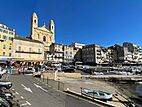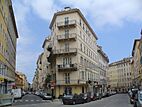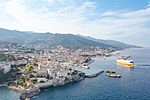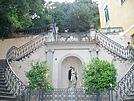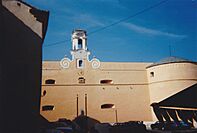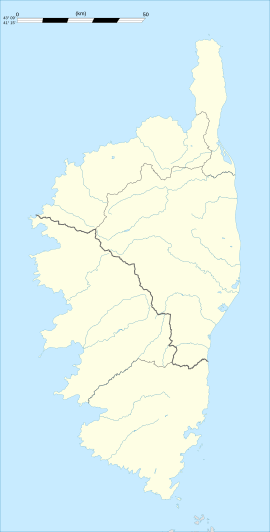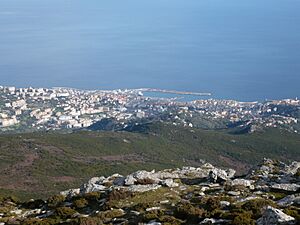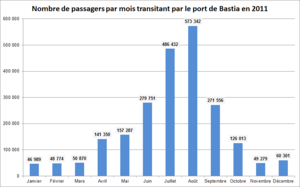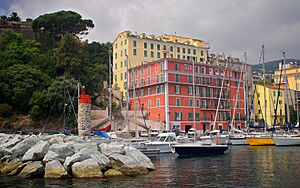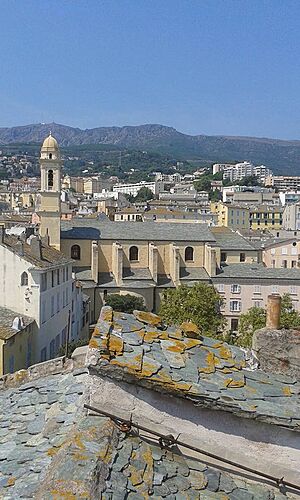Bastia facts for kids
Quick facts for kids
Bastia
Bastìa (Corsican)
|
|||
|---|---|---|---|
|
Prefecture and commune
|
|||
|
From top, left to right: View of St Jean Baptiste Cathedral from the city's port, Boulevard Paoli, aerial view of the port and Bastia's citadel to the left, Romieu Stairs in Romieu Garden, Place Saint-Nicolas with Napoleon Bonaparte statue, Governor's Palace.
|
|||
|
|||
| Country | France | ||
| Region | Corsica | ||
| Department | Haute-Corse | ||
| Arrondissement | Bastia | ||
| Canton | Bastia-1, 2, 3 and 4 | ||
| Intercommunality | CA Bastia | ||
| Area
1
|
19.38 km2 (7.48 sq mi) | ||
| Population
(2021)
|
48,768 | ||
| • Density | 2,516.4/km2 (6,517.5/sq mi) | ||
| Demonym(s) | Bastiais, Bastiaise (FR) bastìacciu, bastìaccia (CO), bastiese (IT) |
||
| Time zone | UTC+01:00 (CET) | ||
| • Summer (DST) | UTC+02:00 (CEST) | ||
| INSEE/Postal code |
2B033 /20200
|
||
| Elevation | 0–963 m (0–3,159 ft) (avg. 30 m or 98 ft) |
||
| 1 French Land Register data, which excludes lakes, ponds, glaciers > 1 km2 (0.386 sq mi or 247 acres) and river estuaries. | |||
Bastia is a city in Corsica, France. It is located in the northeast of the island, at the bottom of Cap Corse. Bastia is the second-largest city on Corsica, right after Ajaccio. It is also the capital of the Bagnaja region.
Bastia is the main port of Corsica and a big center for business. It is also famous for its wines. People who live in Bastia are called Bastiais (for boys and men) or Bastiaises (for girls and women). The city has won awards for its beautiful flowers and villages.
Contents
History of Bastia
How Bastia Began
Long ago, in Roman times, there was no city called Bastia. The area was home to the Vanacimi people. Later, a small fishing village called Porto Cardo existed on the coast. This name means "Cardo Port."
Building the Fortress
In the 1300s, the Republic of Genoa (a powerful Italian state) became involved in Corsica. In 1370, a governor named Leonello Lomellino arrived. He decided to build a strong castle to protect sea routes. This castle was called a bastiglia, which means "fortress." This is where the name Bastia comes from!
Over time, this fortress grew into a city. It became more important than the old village of Cardo. Bastia was the capital of Corsica when the Genoese ruled the island.
Bastia in Modern Times
In the 1500s and 1600s, Franciscan monks settled in the area. A bishop named Agostino Giustiniani described Bastia in the early 1500s. He said it had about 700 houses, split into two parts: Terranova and Terravecchia. Terranova was newer and flatter, with wide streets. Terravecchia was older and steeper.
The city had strong walls, a moat, and impressive bastions (parts of a fortress). The Genoese government built a beautiful citadel, which cost a lot of money. Bastia was important because it was where the governor lived. However, it didn't have a very good port for large ships. People had to get water from a fountain outside the city.
In 1769, France took control of Bastia and the rest of Corsica. Later, in 1794, British troops briefly captured Bastia during a war.
City Symbols: Heraldry
Bastia has its own coat of arms. It shows a silver fortress with towers on a green base, all on a blue background. This symbol represents the city's history and its famous fortress.
| Blazon: Azure, a fortress Argent, turreted, masoned, windows, and port of Sable on a terrace in base Vert. |
Geography of Bastia
Location and Landscape
Bastia is in the northeast of Corsica, at the base of Cap Corse. It sits between the sea and the mountains. It's the main port on the island. The city is about 35 kilometers from the northern tip of Cap Corse. It's also about 50 kilometers west of Elba, an Italian island, and 90 kilometers from mainland Italy. On clear days, you can even see Italy!
Bastia's landscape is shaped by the "Serra di Pignu," a mountain that is 960 meters high. This steep mountain and other hills give the city a unique look. Because of the mountains, Bastia mostly grew along a narrow strip of coast, about 1.5 kilometers wide.
Bastia's Ports
Bastia is a port city, so the sea is very important to it. Today, Bastia has three different ports:
- The Old Port: Called "Vieux Port" in French, this port is in a small, sheltered bay. It was key to the city's early growth. Now, it's home to many pleasure boats and fishing boats. It's also a popular spot for tourists, with cafes, bars, and restaurants along its docks. During summer evenings, these areas are just for pedestrians.
- The Commercial Port: A bit north of the Old Port, this is Bastia's main economic hub. It's very busy, especially in summer, with thousands of passengers and cars arriving and leaving on ferries. This can sometimes cause traffic jams! The large Saint-Nicolas square, the heart of the city, is right in front of this port.
- The Toga Marina: Just north of the commercial port, this marina is for leisure boats like sailboats and yachts. It also has bars, restaurants, and nightclubs.
City Layout
Bastia is built along a narrow north-south line. The city center includes the "citadelle" (stronghold), also called Terra-Nova, where the old Genoese Governors' Palace is. It also has the Old Port area, the market plaza, and the "Boulevard Paoli," which is the main shopping street.
In recent years, Bastia and its surrounding area have grown a lot. This has led to more development outside the main city center.
Rivers and Streams
Bastia has a few small streams, or fiumes, that flow from the mountains to the sea:
- The Ruisseau Fiuminale in the north.
- The Ruisseau de Lupino in the center.
- The Ruisseau de Corbaia in the south.
Climate and Plants
Bastia has a Mediterranean climate. This means it has hot, dry summers and mild, wet winters. The average temperature is about 16.3°C. It gets a lot of sun, with about 240 sunny days each year. Winds are common and can be strong.
The plants in Bastia change depending on the altitude:
- Lower areas (1-100 meters): You'll find plants that like dry summers, like wild olive trees and Mastic shrubs.
- Higher areas (100-1000 meters): Here, it's cooler. You'll see holm oak trees, Maquis shrubland (dense bushes), and arbutus trees. Higher up, where it's rocky, the plants are short and tough because of the strong winds.
Transportation in Bastia
Roads
Bastia has three main roads:
- From the South: The N193 road connects Bastia to other Corsican towns like Ajaccio and Porto-Vecchio. It also passes through nearby towns like Lucciana, where Bastia Poretta Airport is.
- From the West: The D81 road goes to Saint-Florent over the Col de Teghime mountain pass.
- From the North: The D80 road goes around Cap Corse.
Buses
Bastia has a bus system with 14 routes, run by the Autobus Bastiais company.
Trains
The Bastia railway station is in the city center. You can take trains to Ajaccio and Calvi. There are also several smaller train stops within Bastia for local services.
Sea Travel
Bastia's port is one of the busiest in France for passengers, especially on the Mediterranean Sea. In 2011, over 2.2 million passengers passed through it!
Ferries connect Bastia to several ports:
| Port | Number of Passengers in 2014 | Percentage |
|---|---|---|
| Toulon | 548,071 | 25.6% |
| Livorno (Italy) | 529,822 | 24.7% |
| Marseille | 253,899 | 11.9% |
| Nice | 340,007 | 15.9% |
| Savona (Italy) | 324,512 | 15.2% |
| Genoa (Italy) | 110,997 | 5.2% |
| Other routes | 19,790 | 0.9% |
| Portoferraio (Italy) | 14,283 | 0.6% |
| Total | 2,141,381 | 100% |
Most of the passenger traffic happens in the summer (July-August). This is because many tourists visit Corsica during these months. The city needs to have good facilities to handle so many people, even if it's only for a short time each year.
The main ferry company serving Bastia is Corsica Ferries, carrying most of the passengers.
Air Travel
The Bastia – Poretta Airport is about 16 kilometers south of the city. It's the second-busiest airport in Corsica. It has flights to several French cities like Paris, Marseille, and Nice, and some European cities like London and Geneva. Major airlines include Air Corsica and Air France.
City Government
Mayors of Bastia
Bastia has had many mayors over the years. The current mayor is Pierre Savelli, who has been in office since 2016.
- Mayors from 1941
| From | To | Name | Party |
|---|---|---|---|
| 1941 | 1943 | Joseph Gerardi | |
| 1943 | 1945 | Jacques Faggianelli | |
| 1945 | 1947 | Hyacinthe de Montera | |
| 1947 | 1968 | Jacques Faggianelli | Radical |
| 1968 | 1989 | Jean Crucien Zuccarelli | MRG |
| 1989 | 1997 | Emile Pierre Dominique Zuccarelli | PRG |
| 1997 | 2000 | Albert Calloni | |
| 2000 | 2014 | Émile Zuccarelli | |
| 2014 | 2016 | Gilles Simeoni | |
| 2016 | 2026 | Pierre Savelli |
City Divisions
Bastia is part of a larger group of 5 towns called the Agglomeration Community of Bastia. This community had over 57,000 people in 2010. Bastia itself is divided into four smaller areas called cantons.
Sister Cities
Bastia has "twinning" agreements with two other cities:
 Erding in Germany (since 1980)
Erding in Germany (since 1980) Viareggio in Italy (since 1980)
Viareggio in Italy (since 1980)
Population and Schools
Population
In 2017, Bastia had 45,715 people living there. The city's population has changed a lot over time.
| Historical population | ||||||||||||||||||||||||||||||||||||||||||||||||||||||||||||||||||||||||||||||||||||||||||||||||||||||||||||||||
|---|---|---|---|---|---|---|---|---|---|---|---|---|---|---|---|---|---|---|---|---|---|---|---|---|---|---|---|---|---|---|---|---|---|---|---|---|---|---|---|---|---|---|---|---|---|---|---|---|---|---|---|---|---|---|---|---|---|---|---|---|---|---|---|---|---|---|---|---|---|---|---|---|---|---|---|---|---|---|---|---|---|---|---|---|---|---|---|---|---|---|---|---|---|---|---|---|---|---|---|---|---|---|---|---|---|---|---|---|---|---|---|---|
|
|
|||||||||||||||||||||||||||||||||||||||||||||||||||||||||||||||||||||||||||||||||||||||||||||||||||||||||||||||
| Source: EHESS and INSEE | ||||||||||||||||||||||||||||||||||||||||||||||||||||||||||||||||||||||||||||||||||||||||||||||||||||||||||||||||
Education
Bastia has many schools for different age groups:
- 10 kindergartens
- 13 primary schools
- 5 middle schools (colleges)
- 7 high schools
There is also a research institute for engineering and a special institute for training future government officials.
Sports in Bastia
Football (Soccer)
SC Bastia is the main football club in Bastia. They play their games at the Armand-Cesari Stadium in the nearby town of Furiani. The club has a rich history, reaching the UEFA Cup final in 1978 and winning the French Cup in 1981. They have also won the French Ligue 2 championship twice.
Historically, different parts of Bastia supported different football clubs, each with their own colors. But over time, SC Bastia became the most famous.
Other Sports Events
Bastia has also hosted big sports events:
- In 2013, the Tour de France cycling race had a stage that finished in Bastia and another that started there.
- Bastia is the headquarters for the French part of the FIA World Rally Championship, a major car racing event.
City Layout and Districts
Bastia is a port city, so the sea plays a huge role in how the city is organized. As mentioned before, it has three main ports: the Old Port, the Commercial Port, and the Toga Marina.
Main Areas of Bastia
The city center includes:
- The Citadel (also called Terra Nova): This is the old fortress area, home to the Palace of the Governors.
- The Old Port and its surrounding neighborhood.
- The Market Place.
- The Paoli Boulevard: This is the main shopping street, stretching from the courthouse.
Bastia also has several smaller villages and districts:
- Cardo: An old village northeast of the city, one of the first places settled in the area.
- Le Fango: A newer area on the mountainside, home to government offices and a high school.
- Lupino: A southern district, one of the first to be developed with social housing.
- Montesoro: Another residential area in the south with new buildings, shops, and schools.
- Erbajolo: At the very south end of town, marking the start of an industrial zone. It has a large shopping area and a football stadium.
Economy
The Bastia area has most of the few industries found in Corsica. However, the unemployment rate in Bastia has often been high.
The Chamber of Commerce and Industry of Bastia and Upper Corsica manages important facilities:
- Bastia Commercial Port: This port can handle many large ships at once and is the second-largest port in France for passenger traffic.
- Bastia – Poretta Airport: Located south of Bastia, it's a key airport for the region.
Culture and Heritage
Bastia has many historic buildings and sites:
Historic Buildings and Gardens
- The Romieu Public Garden (built in 1874)
- The Law Courts (built in 1856)
- The Governor's Citadel and Palace (from the 14th century): This was once the palace of the Genoese governors. It now houses the municipal museum, where you can learn about Corsican history and culture. The palace was renovated and reopened in 2010.
Churches and Religious Sites
Bastia has many beautiful old churches:
- The Old Church at Cardo (from the 13th century)
- The Church of Saint Charles (built in 1612)
- The Church of Sainte-Marie (from the 17th century): This used to be a cathedral and is located in the heart of the citadel.
- The Church of Saint John the Baptist (built in 1636): This is one of the most famous buildings in Bastia. It overlooks the Old Port and has a grand facade and a beautiful interior.
There are over 200 historical objects in Bastia, including those in its churches and other buildings.
Local Food
When in Bastia, you might try some local foods:
- Sardines au brocciu: Fresh sardines stuffed with Brocciu cheese, made from sheep's milk.
- Baccalà: A dish made from cod fish. It was once considered a simple, affordable meal.
Films Made in Bastia
Several movies have been filmed in Bastia, using its unique scenery:
- Cela s'appelle l'aurore (1955)
- Rosebud (1975)
- Forza Bastia (1978)
- L'Enquête Corse (2004)
- The Man from London
- Mafiosa: A French TV series filmed mostly around Bastia.
Famous People from Bastia
Many notable people were born or lived in Bastia, including:
- Vincent Benedetti (1817–1900), a diplomat.
- César Campinchi (1882–1941), a lawyer and government minister.
- Baptiste Giabiconi (born 1989), a model and singer.
- Henry Padovani (born 1952), the first guitarist for the band The Police.
- Adil Rami (born 1985), a famous footballer.
- Gilles Simeoni (born 1967), a lawyer and politician.
- César Vezzani (1888–1951), a very famous opera singer.
See also
 In Spanish: Bastia para niños
In Spanish: Bastia para niños


